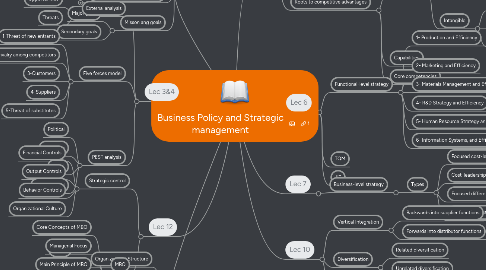
1. Lec 11
1.1. Organizational Structure
1.1.1. Design
1.1.2. Role
1.2. Authority patterns in organizations
1.2.1. Centralized
1.2.2. Decentralized
1.3. Vertical Differentiation
1.3.1. Span of control
1.3.2. Organizational hierarchy
1.3.2.1. Tall structures
1.3.2.2. Flat structures
1.4. Horizontal Differentiation
1.4.1. Functional Structure
1.4.2. Matrix Structure
1.4.3. Product-Team Structure
1.4.4. Multidivisional Structure
1.4.5. Geographic Structure
2. Lect 1&2
2.1. Strategic planing
2.1.1. SWOT analysis
2.2. SWOT analysis
2.2.1. Mission and goals
2.2.2. External analysis
2.2.3. Internal analysis
2.3. Strategic managers for all levels
2.3.1. Detail 1
2.3.2. Detail 2
2.4. Misson ang goals
2.4.1. Major goals
2.4.2. Secondary goals
3. Lec 3&4
3.1. External analysis
3.1.1. Opportunities
3.1.2. Threats
3.2. Five forces model
3.2.1. 1-Threat of new entrants
3.2.2. 2-Intensity of rivalry among competitors
3.2.3. 3-Customers
3.2.4. 4-Suppliers
3.2.5. 5-Threat of substitutes
3.3. PEST analysis
3.3.1. Political
3.3.2. Economic
3.3.3. Social
3.3.4. Technological
4. Lec 12
4.1. Strategic control
4.1.1. Financial Controls
4.1.2. Output Controls
4.1.3. Behavior Controls
4.1.4. Organizational Culture
4.2. MBO
4.2.1. Core Concepts of MBO
4.2.2. Managerial Focus
4.2.3. Main Principle of MBO
4.2.4. Where to Use MBO
4.2.5. The Five-Step MBO Process
5. Lec 5
5.1. Internal analysis
5.1.1. Strength
5.1.2. Weakness
5.2. Roots to competitive advantages
5.2.1. Resources
5.2.1.1. Tangible
5.2.1.1.1. Financial resources
5.2.1.1.2. Organizational resources
5.2.1.1.3. Physical resources
5.2.1.1.4. Technological resources
5.2.1.2. Intangible
5.2.1.2.1. Human resources
5.2.1.2.2. Reputational resources
5.2.1.2.3. Innovation resources
5.2.2. Capabilities
5.2.3. Core competencies
6. Lec 6
6.1. Functional-level strategy
6.1.1. 1- Production and Efficiency
6.1.1.1. Economies of scale
6.1.1.2. Learning effects
6.1.2. 2- Marketing and Efficiency
6.1.3. 3- Materials Management and Efficiency
6.1.4. 4- R&D Strategy and Efficiency
6.1.5. 5- Human Resource Strategy and Efficiency
6.1.6. 6- Information Systems, and Efficiency
6.2. TQM
6.3. JIT
7. Lec 7
7.1. Business-level strategy
7.1.1. Types
7.1.1.1. Focused cost-leadership strategy
7.1.1.2. Cost-leadership streategy
7.1.1.3. Focused differentiation strategy
7.1.1.4. Differentiation strategy
8. Lec 10
8.1. Vertical Integration
8.1.1. Backwards into supplier functions
8.1.2. Forwards into distributor functions
8.2. Diversification
8.2.1. Related diversification
8.2.2. Unrelated diversification

